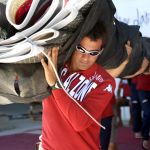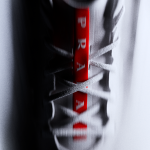
The rise of a new Luna Rossa
Everything you need to know about the new Ac75 that will try to bring the American's Cup in Italy
October 3rd, 2019
Since 1997 the dream of Patrizio Bertelli and Miuccia Prada is to bring the America's Cup on board a Prada hull for the first time in Italy.
The Luna Rossa team was very close to win the trophy in the legendary American's Cup in 2000 against team New Zealand. That first experience was a milestone for the Italian brand and led to the development of Linea Rossa, the brand's first sports line and the true beginning of the sportswear trend. Yesterday in Cagliari dock, the new Luna Rossa was officially unveiled, the hull that will represent Italy and the Circolo della Vela Sicilia at the next America's Cup to be held in 2021 in New Zealand.
The launch was entrusted to Miuccia Prada - Patrizio Bertelli's wife, President of Luna Rossa Prada Pirelli Team - who followed the maritime tradition of splitting a bottle on the hull to wish the team good luck.
The AC75
The AC75 Class represents a return to the monohull but with a revolutionary new interpretation, featuring pioneering technology that opens up a new approach to yacht design.
The AC75 Luna Rossa, built by the Persico Marine boatyard, involved over 90 people in her construction, including 37 team designers, and took almost two years to build, for a total of 78,000 work hours. 7,000 sq.m. of carbon fibre and 400 sq.m. of aluminium honeycomb were used to create the hull. The two innovative carbon-fibre ‘foil arms’, weighing 500 kg each, have been designed to support a maximum load of 27 tonnes. Another innovative feature of the AC75 is the ‘soft wing’ rig, with two sails hoisted in parallel and in-built systems to control the sail shape. This provides the efficiency of a hard wing combined with ease of use and handling akin to a traditional sail. 20,000 km of carbon fibre thread was used to create the mainsail, in addition to 5,000 km for each jib and 12,000 km for each ‘code zero’, used to sail downwind in light breeze.


















